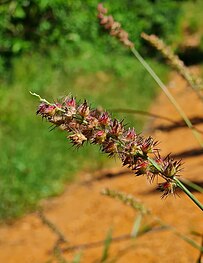Global Distribution
provided by Bibliotheca Alexandrina LifeDesk
Native to warmer parts of the New World, now widely naturalized as a weed throughout the tropics and subtropics.
- author
- BA Cultnat
- provider
- Bibliotheca Alexandrina
Comments
provided by eFloras
The name Cenchrus caliculatus Cavanilles has been misapplied to this species in China. Cenchrus caliculatus is a larger species with culms to 2 m tall and an inflorescence to 24 cm. It is further distinguished by its burrs, which have only a shallow basal cupule. It occurs in Indonesia, Australia, and the S Pacific Islands.
- license
- cc-by-nc-sa-3.0
- copyright
- Missouri Botanical Garden, 4344 Shaw Boulevard, St. Louis, MO, 63110 USA
Description
provided by eFloras
Annuals; culm slightly compressed, base geniculate and usually rooting. Blade 6-20 cm long, 3-8
mm wide; sheath keeled, overlapping at base; ligule a ring of hairs, ca. 1 mm long. Inflorescence a single
raceme, 3-10 cm long; axis scabrous. Spikelets 3-6, lanceolate, acuminate, 4.5-7 mm long, enclosed
in a spiny bur; lower glume narrow, 1-veined, ca. 2.5 mm long; upper glume 2/3-3/4 as long as subequal
lower and upper lemma; anther ca. 2.8 mm long. Bur truncate at base, body 4-7 mm high, as broad or
broader, pubescent, outer bristles slender, usually less numerous, inner bristles stout, usually broadened
at base and equaling lobes of body or shorter, lobes of body 10, often pilose, erect or bent inwards.
Tropical America, but naturalized in many warmer regions of the world. Taiwan, in sandy places.
- license
- cc-by-nc-sa-3.0
- copyright
- Missouri Botanical Garden, 4344 Shaw Boulevard, St. Louis, MO, 63110 USA
Description
provided by eFloras
Annual. Culms geniculate, usually rooting at basal nodes, 15–90 cm tall. Leaf sheaths keeled, usually imbricate at base; leaf blades linear or linear-lanceolate, 5–20(–40) × 0.4–1 cm, glabrous to pubescent; ligule ca. 1 mm. Inflorescence 3–10 × ca. 1 cm, burrs contiguous, rachis scabrous. Burrs globose, 0.4–1 cm, truncate, stipe pubescent, all spines and bristles retrorsely barbed; inner spines connate for 1/3–1/2 their length forming a globose cupule, the flattened free tips triangular, erect or bent inward, cupule and tips pubescent, outer spines in 2 divergent whorls, a median whorl of stout rigid spines equaling the inner teeth, and an outermost whorl of relatively few short, slender bristles. Spikelets 2–4 in burr, 4.5–7 mm; lower glume 1/2 spikelet length; upper glume 2/3–3/4 spikelet length. Fl. and fr. summer. 2n = 34, 68.
- license
- cc-by-nc-sa-3.0
- copyright
- Missouri Botanical Garden, 4344 Shaw Boulevard, St. Louis, MO, 63110 USA
Habitat & Distribution
provided by eFloras
Seashore sand dunes, roadsides, waste places. Fujian, Guangdong, Hainan, Taiwan, Yunnan [native to America; now a widespread weed of the tropics and subtropics].
- license
- cc-by-nc-sa-3.0
- copyright
- Missouri Botanical Garden, 4344 Shaw Boulevard, St. Louis, MO, 63110 USA
Physical Description
provided by USDA PLANTS text
Annuals, Terrestrial, not aquatic, Stems nodes swollen or brittle, Stems erect or ascending, Stems geniculate, decumbent, or lax, sometimes rooting at nodes, Stems caespitose, tufted, or clustered, Stems terete, round in cross section, or polygonal, Stem internodes solid or spongy, Stems with inflorescence less than 1 m tall, Stems, culms, or scapes exceeding basal leaves, Leaves mostly cauline, Leaves conspicuously 2-ranked, distichous, Leaves sheathing at base, Leaf sheath mostly open, or loose, Leaf sheath smooth, glabrous, Leaf sheath and blade differentiated, Leaf blades linear, Leaf blades 2-10 mm wide, Leaf blades mostly flat, Leaf blades more or less hairy, Ligule present, Ligule a fringed, ciliate, or lobed membrane, Ligule a fringe of hairs, Inflorescence terminal, Inflorescence a contracted panicle, narrowly paniculate, branches appressed or ascending, Inflorescence a dense slender spike-like panicle or raceme, branches contracted, Inflorescence solitary, with 1 spike, fascicle, glomerule, head, or cluster per stem or culm, Flowers bisexual, Spikelets sessile or subsessile, Spikelets dorsally compressed or terete, Spikelet 3-10 mm wide, Spikelets with 1 fertile floret, Spikelets with 2 florets, Spikelets solitary at rachis nodes, Spikelets 1-4 in short bristly fascicles, Spikelets all alike and fert ille, Spikelets bisexual, Spikelets disarticulating below the glumes, Spikelets falling with parts of disarticulating rachis or pedicel, Spikelets in bur-like clusters or fascicles with fused bracts, bristles or spines, Spikelet bristles fused together, Spikelets all subtended by bristles, Spikelet bristles 4-many, Spikelet bracts or bristles disarticulating with spikelet, Spikelets in dense head-like clusters, Rachilla or pedicel glabrous, Pistillate spikelet enclosed in hard bony involucre, Glumes present, empty bracts, Glumes 2 clearly present, Glumes distinctly unequal, Glumes shorter than adjacent lemma, Glumes equal to or longer than adjacent lemma, Glume equal to or longer than spikelet, Glumes 1 nerved, Glumes 3 nerved, Glumes 4-7 nerved, Lemma similar in texture to glumes, Lemma coriaceous, firmer or thicker in texture than the glumes, Lemma 3 nerved, Lemma 5-7 nerved, Lemma glabrous, Lemma apex truncate, rounded, or obtuse, Lemma awnless, Lemma straight, Palea pres ent, well developed, Palea membranous, hyaline, Palea about equal to lemma, Stamens 3, Styles 1, Styles 2-fid, deeply 2-branched, Stigmas 2, Fruit - caryopsis, Caryopsis ellipsoid, longitudinally grooved, hilum long-linear.
Cenchrus echinatus: Brief Summary
provided by wikipedia EN
Cenchrus echinatus is a species of grass known by the common names southern sandbur, spiny sandbur, southern sandspur, and in Australia, Mossman River grass. It is native to North and South America.

Cenchrus echinatus in
Brazil It is a clump-forming annual grass growing up to 80 cm (31 in) tall. The leaves occur with or without hairs and measure up to 12 mm (0.47 in) wide. The ligule is a fringe of hairs. The grass has barbed burrs of 4–10 mm (0.16–0.39 in) long.
In Australia it forms an invasive weed in coastal situations.

- license
- cc-by-sa-3.0
- copyright
- Wikipedia authors and editors



 Cenchrus echinatus in Brazil
Cenchrus echinatus in Brazil 